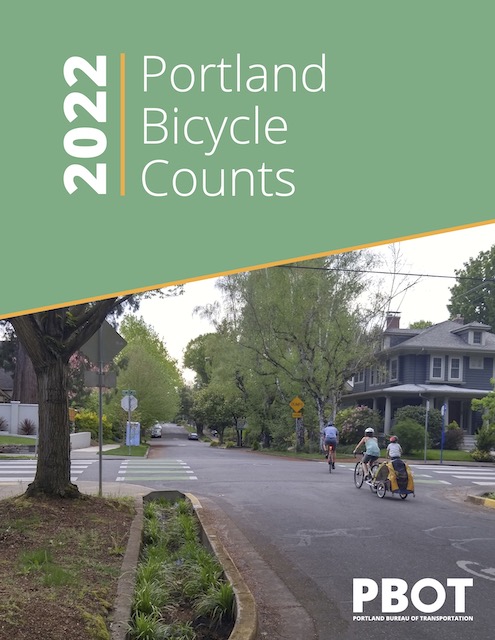Portland, Oregon has 385 miles of bikeways, 121 of which have been built since 2014. But these bikeways have failed to boost the number of bicycle riders in the city. In fact, a report from the city of Portland says that, in the wake of COVID, the number is declining rapidly.
According to the Census Bureau’s American Community Survey, the share of Portland employees riding bicycles to work peaked at 7.2 percent in 2014. By 2019, it had fallen to 5.2 percent. The pandemic led to a surge in bicycle sales, and the share grew to 5.4 percent in 2020 but then fell dramatically to a measly 2.8 percent in 2021.
In terms of actual numbers, cycle commuters peaked in 2015 at 23,432, but fell by 57 percent to 9,985 in 2022. People apparently discovered they didn’t like riding in the rain.
These numbers are mirrored by city of Portland efforts to count cyclists at dozens of intersections scattered throughout the city. These counts are done at least every three years including 2013, 2016, 2019, and 2022.
The counts show that the number of cyclists grew slightly (0.5 percent) between 2013 and 2016, but declined by 11.5 percent between 2016 and 2019. The drop from 2019 to 2022 was an even more precipitous 34.9 percent.
The 2022 count was down “to levels not seen since approximately 2005-2006,” says the city. For what it’s worth, the report also notes that about two-thirds of cyclists are men, about 80 percent wear helmets.
Of Portland’s 385 miles of bikeways, 171 miles are bike lanes added to busy streets, usually by taking out lanes previously open to automobiles. Another 94 miles are what the city calls “neighborhood greenways” but what I call bicycle boulevards. Most of the rest, 85 miles, are bike paths.
Nearly a third of these bikeway miles were built since 2014. This led the city report to note, “It is easy to argue that Portland’s bikeway network is of higher quality and reaches into more parts of the city than in 2014- 2015 when bicycle commute mode split and the number of people biking to work peaked.”
In addition, in 2016 Portland began a shared bike program that offers 1,500 electric-assist bicycles that people can use throughout the city. It even has a program to subsidize the use of shared bikes by low-income people. Yet only 2,630 people had signed up to use shared bikes, of which 1,403 received subsidies to do so.
“Despite these efforts,” concludes the report, “bicycle use—as reflected in both commute data and the city’s annual counts— has continued to drop.” Evidently, in Portland, just because you build it doesn’t mean people will use it.









People apparently discovered they didn’t like riding in the rain.”
MAN UP PUSSY
https://i.pinimg.com/736x/71/81/88/718188dc64d3ae7a1267bbd403edb810.jpg
https://www.forbes.com/sites/carltonreid/2023/03/01/cyclists-now-outnumber-motorists-in-city-of-london/
Cyclists are now the “single largest vehicular mode counted during peak times on City streets,” says a report to the transportation committee of the City of London Corporation, the municipal governing body of London’s square mile.
“People apparently discovered they didn’t like riding in the rain.”
From the London report:
” The 24-hour traffic count was conducted on a wet and windy November day last year.”
Today in Portland my son was assaulted while riding his bike. My son can take care of himself, but not against 4 hooded and masked men in a car.
They threw urine on him, hoping to provoke a fight and stealing his bike. He got out of there fast!
He was 2 blocks from home.
janehavisham,
Thanks for that useful information about London. For those who don’t know, the “city of London” occupies 1.1 square miles in the center of greater London, which is more than 600 square miles. So bicycles may outnumber motor vehicles in 0.2 percent of London, but even with higher fuel prices, motor vehicles outnumber bicycles in the rest of the urban area.
During the pandemic, the proportion of journeys in London made by bike increased by 48%. There is data to suggest that leisure cycling has boomed since the start of the pandemic.
Because when supply chains crashed…. automobile parts, fuel and services became scarce. Bikes a simple domestic technology…. we’re immune to fuel price hikes. Where’d this happen before …World War II.
Let’s be frank, Europe didn’t heavily adopt bicycle and pedestrian infrastructure and build transit because they care for the environment; that’s side circumstance. They did it because of energy crisis. Even After World War II Europe went thru multiple energy crisis and Still is Today!
Europe is an energy intensive region heavily reliant on imports; already today, it imports 50% of its energy needs, projected to increase to 70% within two decades. US solved it’s energy crisis with Fracking; Europe wont/cant do that. Europe has had energy shortages since before WWII; so stringent energy efficiency requirements and rationing were common in Europe.
as city centers continually struggle, they double down on ways to make sure they can’t continue to be employment centers.
cell phone tower data from the city of boston suggests the city is down 50% on daily population from prepandemic.
manhattan appears to be entering a suicide pact getting rid of car parking, adding congestion charges to “fix” the mta with the political divide it creates with the outer boroughs, while midtown remains pretty empty and a recession looming.
really unclear what the endgame here is, because none of it seems very sustainable.